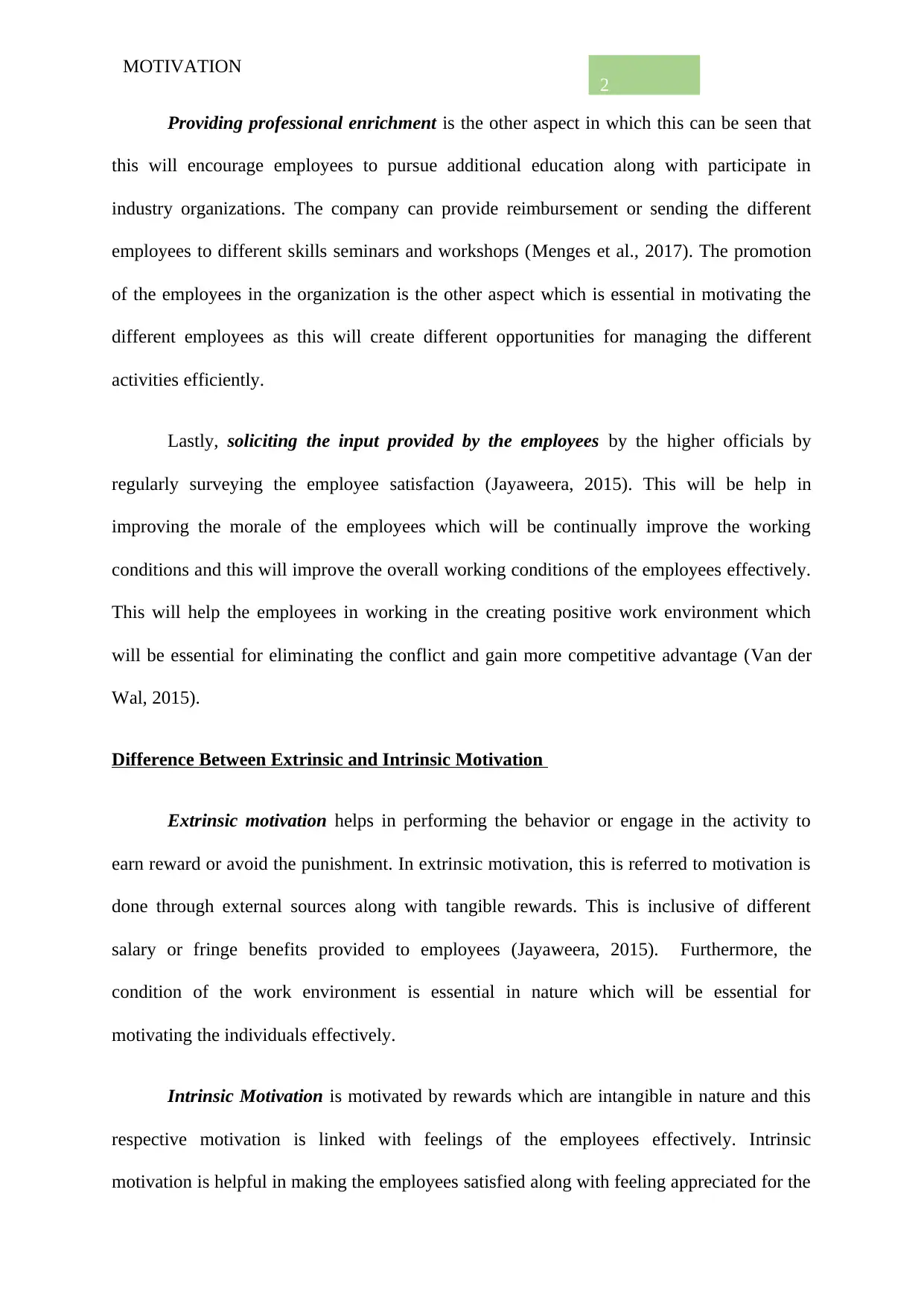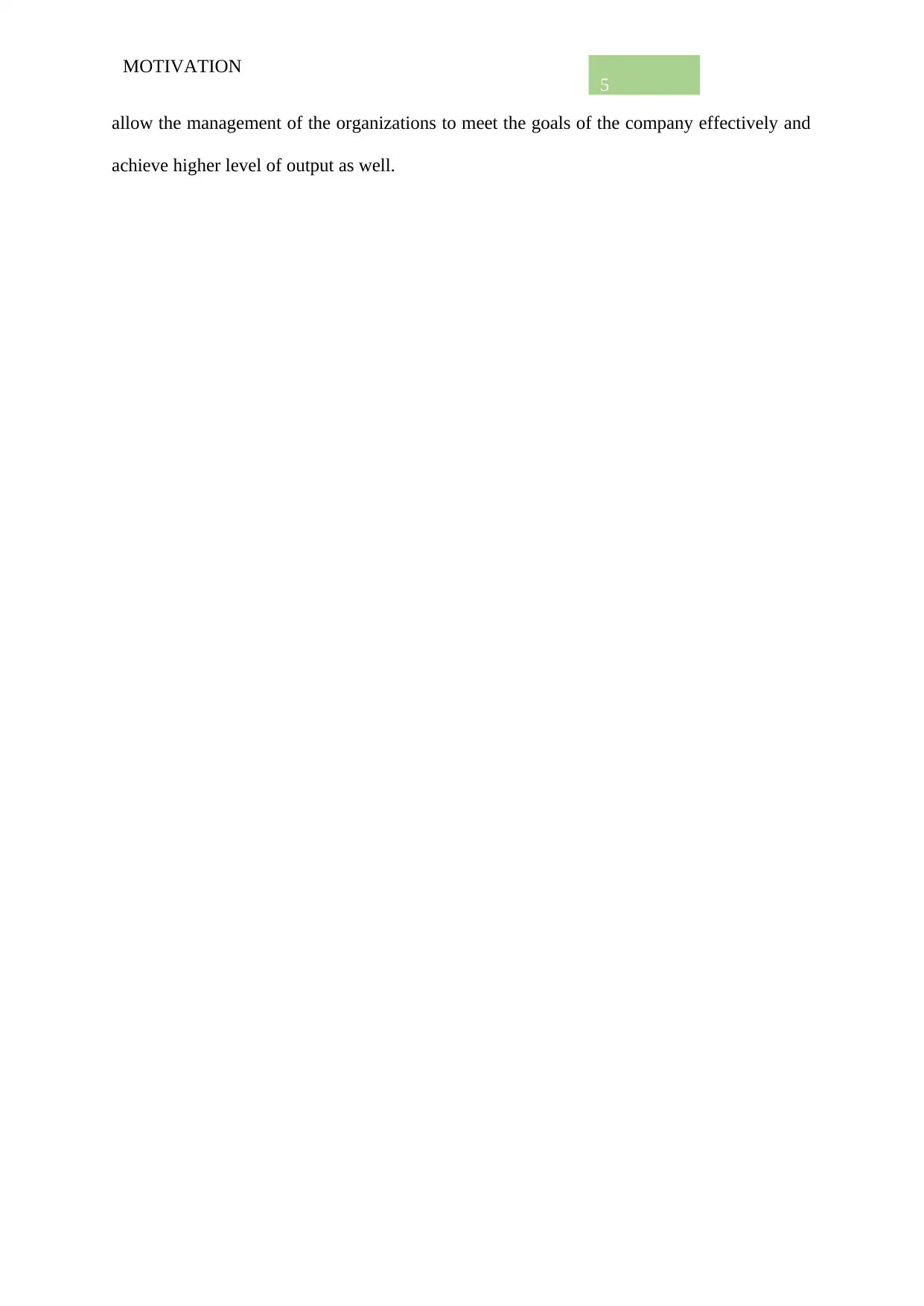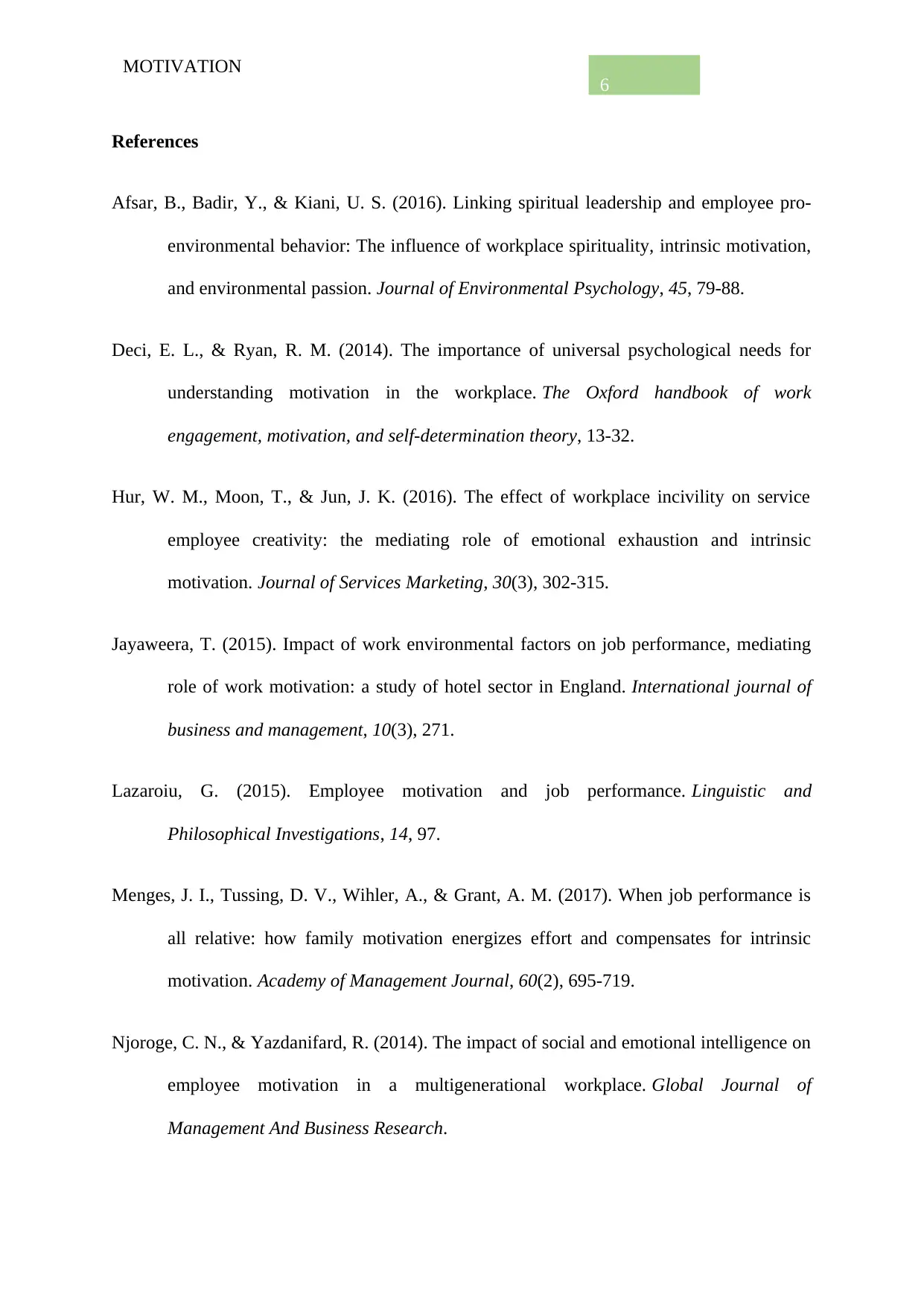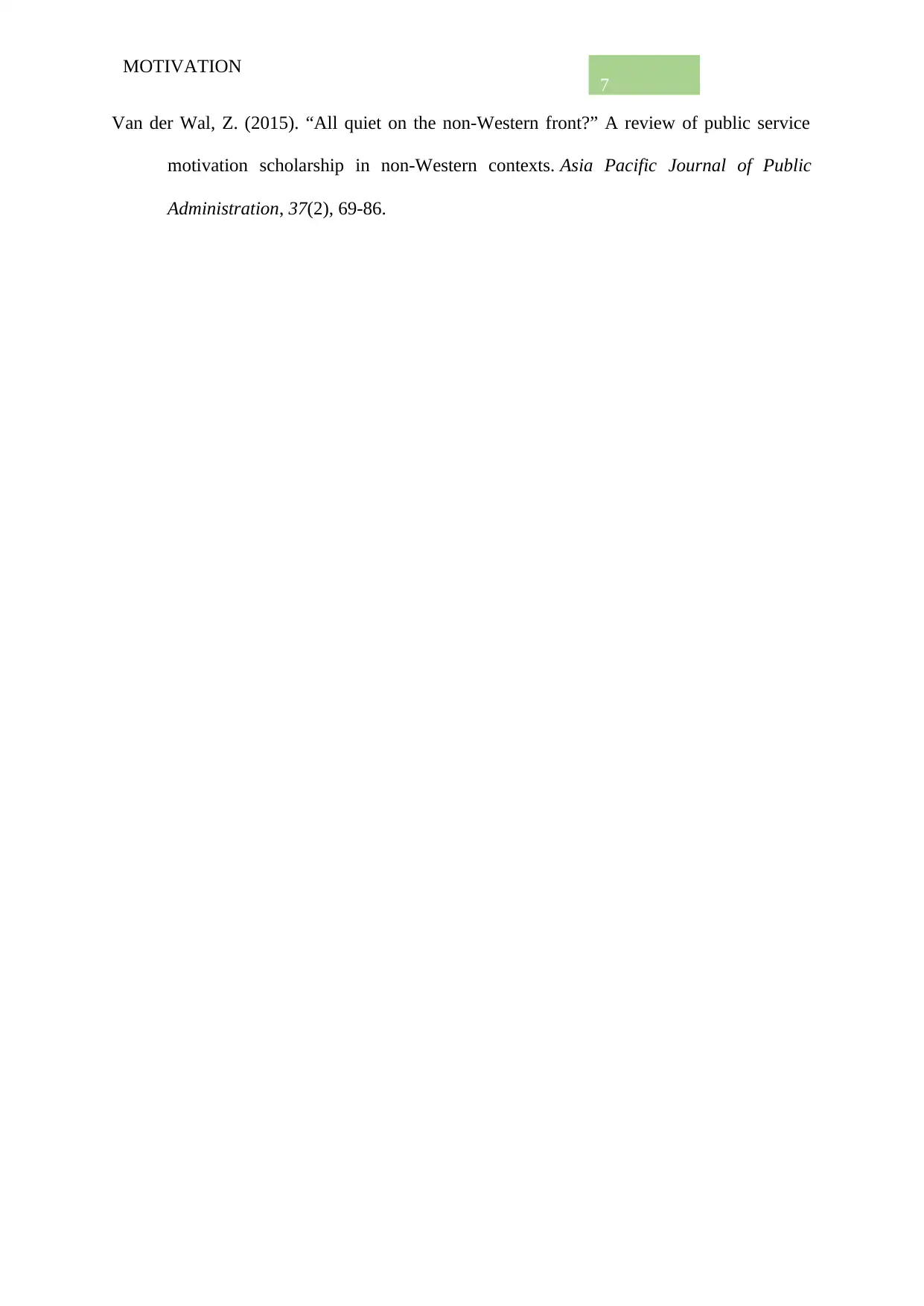Improving Staff Motivation: Techniques and Theories Analysis
VerifiedAdded on 2023/06/03
|8
|1601
|409
Essay
AI Summary
This essay provides an analysis of various techniques used to improve staff motivation in the workplace, differentiating between extrinsic and intrinsic motivation with real-world examples. It explores techniques such as providing incentives, regular feedback, professional enrichment, and soliciting employee input. The essay also discusses the importance of balancing intrinsic and extrinsic motivation, referencing Maslow’s Hierarchy Theory and Herzberg’s theory to highlight the significance of job satisfaction and hygiene needs. A personal example illustrates the impact of effective leadership and reward management on employee morale and productivity, concluding that motivation is crucial for achieving organizational goals and improving overall output. Desklib provides access to similar essays and resources for students.

Running head: MOTIVATION
Motivation
Name of the Student
Name of the University
Author note
Motivation
Name of the Student
Name of the University
Author note
Paraphrase This Document
Need a fresh take? Get an instant paraphrase of this document with our AI Paraphraser

1
MOTIVATION
Introduction
The essay helps in analysis of different techniques which will be helpful in improving
the motivation of the staffs in the workplace. The difference between the extrinsic and
intrinsic motivation is required to be analysed effectively with analysis of the working life
examples. With the utilization of the different theories related to motivation, proper analysis
is required to be done effectively related to motivation of employees.
Techniques Used in Motivating Staffs in Workplace
There are different techniques which can be used in order to motivate the staffs in the
workplace which is inclusive of the following:
According to Afsar, Badir and Kiani, (2016), providing incentives is one of the
aspects which will be helpful for the employees in working with more proper increase in the
morale of the employees. There can be financial and non-financial incentives for the
employees wherein financial incentives is inclusive of gift cards and restaurant gift
certificates. On the other hand, non-financial incentives is inclusive of parking spots or extra
vocation days which will be helpful in managing the overall efficiency of the tasks performed
by them.
Providing regular, direct and supportive feedback is essential to be provided to the
employees working in the organization as this will create a positive impact on the overall
performance of employees. As per Deci and Ryan (2014), feedback is required to be timely
along with specific in nature as this will guide the employees in performing better. The
performance enhancing feedback along with training will motivate them in performing
effectively and this will enhance their performance and productivity (Njoroge & Yazdanifard,
2014).
MOTIVATION
Introduction
The essay helps in analysis of different techniques which will be helpful in improving
the motivation of the staffs in the workplace. The difference between the extrinsic and
intrinsic motivation is required to be analysed effectively with analysis of the working life
examples. With the utilization of the different theories related to motivation, proper analysis
is required to be done effectively related to motivation of employees.
Techniques Used in Motivating Staffs in Workplace
There are different techniques which can be used in order to motivate the staffs in the
workplace which is inclusive of the following:
According to Afsar, Badir and Kiani, (2016), providing incentives is one of the
aspects which will be helpful for the employees in working with more proper increase in the
morale of the employees. There can be financial and non-financial incentives for the
employees wherein financial incentives is inclusive of gift cards and restaurant gift
certificates. On the other hand, non-financial incentives is inclusive of parking spots or extra
vocation days which will be helpful in managing the overall efficiency of the tasks performed
by them.
Providing regular, direct and supportive feedback is essential to be provided to the
employees working in the organization as this will create a positive impact on the overall
performance of employees. As per Deci and Ryan (2014), feedback is required to be timely
along with specific in nature as this will guide the employees in performing better. The
performance enhancing feedback along with training will motivate them in performing
effectively and this will enhance their performance and productivity (Njoroge & Yazdanifard,
2014).

MOTIVATION 2
Providing professional enrichment is the other aspect in which this can be seen that
this will encourage employees to pursue additional education along with participate in
industry organizations. The company can provide reimbursement or sending the different
employees to different skills seminars and workshops (Menges et al., 2017). The promotion
of the employees in the organization is the other aspect which is essential in motivating the
different employees as this will create different opportunities for managing the different
activities efficiently.
Lastly, soliciting the input provided by the employees by the higher officials by
regularly surveying the employee satisfaction (Jayaweera, 2015). This will be help in
improving the morale of the employees which will be continually improve the working
conditions and this will improve the overall working conditions of the employees effectively.
This will help the employees in working in the creating positive work environment which
will be essential for eliminating the conflict and gain more competitive advantage (Van der
Wal, 2015).
Difference Between Extrinsic and Intrinsic Motivation
Extrinsic motivation helps in performing the behavior or engage in the activity to
earn reward or avoid the punishment. In extrinsic motivation, this is referred to motivation is
done through external sources along with tangible rewards. This is inclusive of different
salary or fringe benefits provided to employees (Jayaweera, 2015). Furthermore, the
condition of the work environment is essential in nature which will be essential for
motivating the individuals effectively.
Intrinsic Motivation is motivated by rewards which are intangible in nature and this
respective motivation is linked with feelings of the employees effectively. Intrinsic
motivation is helpful in making the employees satisfied along with feeling appreciated for the
Providing professional enrichment is the other aspect in which this can be seen that
this will encourage employees to pursue additional education along with participate in
industry organizations. The company can provide reimbursement or sending the different
employees to different skills seminars and workshops (Menges et al., 2017). The promotion
of the employees in the organization is the other aspect which is essential in motivating the
different employees as this will create different opportunities for managing the different
activities efficiently.
Lastly, soliciting the input provided by the employees by the higher officials by
regularly surveying the employee satisfaction (Jayaweera, 2015). This will be help in
improving the morale of the employees which will be continually improve the working
conditions and this will improve the overall working conditions of the employees effectively.
This will help the employees in working in the creating positive work environment which
will be essential for eliminating the conflict and gain more competitive advantage (Van der
Wal, 2015).
Difference Between Extrinsic and Intrinsic Motivation
Extrinsic motivation helps in performing the behavior or engage in the activity to
earn reward or avoid the punishment. In extrinsic motivation, this is referred to motivation is
done through external sources along with tangible rewards. This is inclusive of different
salary or fringe benefits provided to employees (Jayaweera, 2015). Furthermore, the
condition of the work environment is essential in nature which will be essential for
motivating the individuals effectively.
Intrinsic Motivation is motivated by rewards which are intangible in nature and this
respective motivation is linked with feelings of the employees effectively. Intrinsic
motivation is helpful in making the employees satisfied along with feeling appreciated for the
⊘ This is a preview!⊘
Do you want full access?
Subscribe today to unlock all pages.

Trusted by 1+ million students worldwide

MOTIVATION 3
different kinds of tasks provided to employees in workplace (Jayaweera, 2015). Intrinsic
motivation comes from within and this is being provided by higher official employer to
employees is officially recognized.
Balance of both intrinsic and extrinsic motivation is essential wherein the intrinsic
motivation is considered as continuum. It can be seen that there are few employees in the
workplace wherein the salaries and physical work environment plays a major role in
managing the different tasks effectively. On the other hand, there are employees who prefer
intrinsic motivation is essential in nature wherein feeling appreciated and feeling capable is
essential to increase the morale of employees and increasing the overall productivity of the
employees effectively (Hur, Moon & Jun, 2016).
There are few employees in different organizations who prefer extrinsic kind of
motivation which will be beneficial for the overall success of the organization in an efficient
manner. Satisfaction and Dissatisfaction are required to be taken into consideration which
will be beneficial to improve the morale of employees and this is helpful in managing the
motivation among the different employees efficiently.
With the implementation of Maslow’s Hierarchy Theory and Herzberg’s theory, this
can be combination of both hygiene and the motivational aspects which are required to be
provided to employees effectively. With the implementation of Herzberg’s motivational
approach, this will be creating opportunities for growth along with advancement in an
appropriate manner (Lazaroiu, 2015). The job satisfaction along with improving the overall
productivity of the organization in an efficient manner. This respective theory helps in
suggesting that this will help in improving the productivity and job attitude of the individuals
towards the job performed by them.
different kinds of tasks provided to employees in workplace (Jayaweera, 2015). Intrinsic
motivation comes from within and this is being provided by higher official employer to
employees is officially recognized.
Balance of both intrinsic and extrinsic motivation is essential wherein the intrinsic
motivation is considered as continuum. It can be seen that there are few employees in the
workplace wherein the salaries and physical work environment plays a major role in
managing the different tasks effectively. On the other hand, there are employees who prefer
intrinsic motivation is essential in nature wherein feeling appreciated and feeling capable is
essential to increase the morale of employees and increasing the overall productivity of the
employees effectively (Hur, Moon & Jun, 2016).
There are few employees in different organizations who prefer extrinsic kind of
motivation which will be beneficial for the overall success of the organization in an efficient
manner. Satisfaction and Dissatisfaction are required to be taken into consideration which
will be beneficial to improve the morale of employees and this is helpful in managing the
motivation among the different employees efficiently.
With the implementation of Maslow’s Hierarchy Theory and Herzberg’s theory, this
can be combination of both hygiene and the motivational aspects which are required to be
provided to employees effectively. With the implementation of Herzberg’s motivational
approach, this will be creating opportunities for growth along with advancement in an
appropriate manner (Lazaroiu, 2015). The job satisfaction along with improving the overall
productivity of the organization in an efficient manner. This respective theory helps in
suggesting that this will help in improving the productivity and job attitude of the individuals
towards the job performed by them.
Paraphrase This Document
Need a fresh take? Get an instant paraphrase of this document with our AI Paraphraser

MOTIVATION 4
For instance- When I used to work in the previous organization as an employee, my
team leader was effective in providing with different kinds of job satisfaction which was
efficient and useful in increasing the morale of mine and the other colleagues. There was a
situation wherein I had to perform a finance related task and my team leader helped and
assisted me in successfully completing the task. In the organization, there was different
reward management techniques which was used by the higher officials in motivating us and
this helped us in improving the overall productivity of the organization.
The best part of the organizational activities was that there was huge job satisfaction
along with financial rewards which was being provided to the employees. I received financial
rewards along with gained much appreciation and satisfaction related to job after the overall
completion of the job within the specified time frame. With the implementation of both
Maslow’s and Herzberg’s theory, I tried to become more effective in performing the different
tasks and this helped me in managing the overall efficiency of the tasks which was performed
by me as well.
Conclusion
Therefore, this can be concluded that motivation is one of the crucial aspects which is
required to be taken into consideration while completing the different tasks in the
organization. Both financial and non-financial rewards are taken into consideration which
will be helpful in understanding the different efficiency of the organization along with
improving the morale of the employees in performing the different activities in an appropriate
manner.
Both job satisfaction along with hygiene needs are essential in nature which will be
helpful in appreciating the different tasks performed by the employees working in the
organization. Lastly, with the help of motivational approaches, this will be beneficial and
For instance- When I used to work in the previous organization as an employee, my
team leader was effective in providing with different kinds of job satisfaction which was
efficient and useful in increasing the morale of mine and the other colleagues. There was a
situation wherein I had to perform a finance related task and my team leader helped and
assisted me in successfully completing the task. In the organization, there was different
reward management techniques which was used by the higher officials in motivating us and
this helped us in improving the overall productivity of the organization.
The best part of the organizational activities was that there was huge job satisfaction
along with financial rewards which was being provided to the employees. I received financial
rewards along with gained much appreciation and satisfaction related to job after the overall
completion of the job within the specified time frame. With the implementation of both
Maslow’s and Herzberg’s theory, I tried to become more effective in performing the different
tasks and this helped me in managing the overall efficiency of the tasks which was performed
by me as well.
Conclusion
Therefore, this can be concluded that motivation is one of the crucial aspects which is
required to be taken into consideration while completing the different tasks in the
organization. Both financial and non-financial rewards are taken into consideration which
will be helpful in understanding the different efficiency of the organization along with
improving the morale of the employees in performing the different activities in an appropriate
manner.
Both job satisfaction along with hygiene needs are essential in nature which will be
helpful in appreciating the different tasks performed by the employees working in the
organization. Lastly, with the help of motivational approaches, this will be beneficial and

MOTIVATION 5
allow the management of the organizations to meet the goals of the company effectively and
achieve higher level of output as well.
allow the management of the organizations to meet the goals of the company effectively and
achieve higher level of output as well.
⊘ This is a preview!⊘
Do you want full access?
Subscribe today to unlock all pages.

Trusted by 1+ million students worldwide

MOTIVATION 6
References
Afsar, B., Badir, Y., & Kiani, U. S. (2016). Linking spiritual leadership and employee pro-
environmental behavior: The influence of workplace spirituality, intrinsic motivation,
and environmental passion. Journal of Environmental Psychology, 45, 79-88.
Deci, E. L., & Ryan, R. M. (2014). The importance of universal psychological needs for
understanding motivation in the workplace. The Oxford handbook of work
engagement, motivation, and self-determination theory, 13-32.
Hur, W. M., Moon, T., & Jun, J. K. (2016). The effect of workplace incivility on service
employee creativity: the mediating role of emotional exhaustion and intrinsic
motivation. Journal of Services Marketing, 30(3), 302-315.
Jayaweera, T. (2015). Impact of work environmental factors on job performance, mediating
role of work motivation: a study of hotel sector in England. International journal of
business and management, 10(3), 271.
Lazaroiu, G. (2015). Employee motivation and job performance. Linguistic and
Philosophical Investigations, 14, 97.
Menges, J. I., Tussing, D. V., Wihler, A., & Grant, A. M. (2017). When job performance is
all relative: how family motivation energizes effort and compensates for intrinsic
motivation. Academy of Management Journal, 60(2), 695-719.
Njoroge, C. N., & Yazdanifard, R. (2014). The impact of social and emotional intelligence on
employee motivation in a multigenerational workplace. Global Journal of
Management And Business Research.
References
Afsar, B., Badir, Y., & Kiani, U. S. (2016). Linking spiritual leadership and employee pro-
environmental behavior: The influence of workplace spirituality, intrinsic motivation,
and environmental passion. Journal of Environmental Psychology, 45, 79-88.
Deci, E. L., & Ryan, R. M. (2014). The importance of universal psychological needs for
understanding motivation in the workplace. The Oxford handbook of work
engagement, motivation, and self-determination theory, 13-32.
Hur, W. M., Moon, T., & Jun, J. K. (2016). The effect of workplace incivility on service
employee creativity: the mediating role of emotional exhaustion and intrinsic
motivation. Journal of Services Marketing, 30(3), 302-315.
Jayaweera, T. (2015). Impact of work environmental factors on job performance, mediating
role of work motivation: a study of hotel sector in England. International journal of
business and management, 10(3), 271.
Lazaroiu, G. (2015). Employee motivation and job performance. Linguistic and
Philosophical Investigations, 14, 97.
Menges, J. I., Tussing, D. V., Wihler, A., & Grant, A. M. (2017). When job performance is
all relative: how family motivation energizes effort and compensates for intrinsic
motivation. Academy of Management Journal, 60(2), 695-719.
Njoroge, C. N., & Yazdanifard, R. (2014). The impact of social and emotional intelligence on
employee motivation in a multigenerational workplace. Global Journal of
Management And Business Research.
Paraphrase This Document
Need a fresh take? Get an instant paraphrase of this document with our AI Paraphraser

MOTIVATION 7
Van der Wal, Z. (2015). “All quiet on the non-Western front?” A review of public service
motivation scholarship in non-Western contexts. Asia Pacific Journal of Public
Administration, 37(2), 69-86.
Van der Wal, Z. (2015). “All quiet on the non-Western front?” A review of public service
motivation scholarship in non-Western contexts. Asia Pacific Journal of Public
Administration, 37(2), 69-86.
1 out of 8
Related Documents
Your All-in-One AI-Powered Toolkit for Academic Success.
+13062052269
info@desklib.com
Available 24*7 on WhatsApp / Email
![[object Object]](/_next/static/media/star-bottom.7253800d.svg)
Unlock your academic potential
Copyright © 2020–2025 A2Z Services. All Rights Reserved. Developed and managed by ZUCOL.




